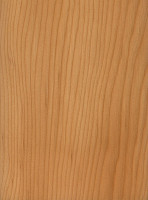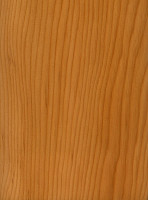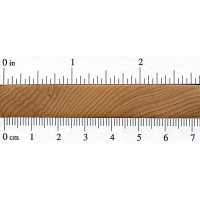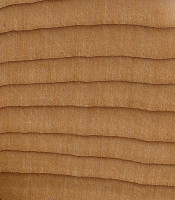 |
Common Name(s): Pacific Yew, Oregon Yew Scientific Name: Taxus brevifolia Distribution: Pacific Northwest North America Tree Size: 30-50 ft (10-15 m) tall, 1-2 ft (.3-.6 m) trunk diameter Average Dried Weight: 44 lbs/ft3 (705 kg/m3) Specific Gravity (Basic, 12% MC): .60, .71 Janka Hardness: 1,600 lbf (7,120 N) Modulus of Rupture: 15,200 lbf/in2 (104.8 MPa) Elastic Modulus: 1,350,000 lbf/in2 (9.31 GPa) Crushing Strength: 8,100 lbf/in2 (55.9 MPa) Shrinkage: Radial: 4.0%, Tangential: 5.4%, Volumetric: 9.7%, T/R Ratio: 1.4 |
Color/Appearance: Sapwood is usually a thin band of pale yellow or tan color, while the heartwood is an orangish brown, sometimes with a darker brown or purplish hue. Color tends to darken with age.
Grain/Texture: Grain is straight, with a fine uniform texture. Good natural luster.
Endgrain: Resin canals absent; earlywood to latewood transition gradual, color contrast medium; tracheid diameter very small.
Rot Resistance: Pacific Yew is very durable in regard to decay resistance, and is also resistant to most insect attack.
Workability: Overall, an easy wood to work, though knots and other grain irregularities can pose a challenge. Yew glues, finishes, and turns well.
Odor: No characteristic odor.
Allergies/Toxicity: Although severe reactions are quite uncommon, Yew has been reported as a irritant. Usually most common reactions simply include eye, skin, and respiratory irritation, as well as nausea, headache, and cardiac effects. Additionally, nearly all parts of the Yew tree are considered toxic and poisonous to humans, and care should be exercised when working with this wood species. See the articles Wood Allergies and Toxicity and Wood Dust Safety for more information.
Pricing/Availability: Yew is relatively uncommon, and larger tree trunks are usually hollow. Selection and sizes are somewhat limited, especially since most trunks are also full of knots, resulting in a high waste factor for many projects. Though sections of wood can sometimes be obtained for moderate prices, the overall cost of usable wood tends to be high.
Sustainability: This wood species is not listed in the CITES Appendices, but is reported by the IUCN as being near threatened. Technically it doesn’t meet the Red List criteria of a vulnerable or endangered species, but is close to qualifying and/or may qualify in the near future.
Common Uses: Bows (archery), veneer, cabinetry, furniture, carvings, musical instruments (lutes), and turned objects.
Comments: Perhaps among the hardest of all softwood species, Yew is certainly a unique wood species. Its density and working characteristics are more inline with a heavy hardwood than a softwood, yet its tight, fine grain and smooth texture give it a lustrous finish.
Yet perhaps Yew’s greatest claim to fame is that of its mechanical properties: despite its strength and density, Yew has an incredibly low and disproportionate modulus of elasticity at only 1,320,000 lbf/in2 (9,100 MPa). What this means is that the wood is extremely flexible, yet strong, making it ideally suited for use in archery bows. In fact, Yew was the wood of choice for English longbows in medieval warfare.
 |
 |
 |
 |





In the 1980s I got a permit from Willamette National Forest in Oregon to harvest a dozen or so Yew trees for “fence-posts.” I recruited several members of my family including both my parents to help in the effort and we all had a great time working in the shade of huge overstory Douglas Fir trees, sawing down, then bucking the Yew into 12 foot lengths (as required by the Forest Service) and pulling them out behind a borrowed 3-Wheeler. The logs ranged from about 6 inches diameter at the butt up to 16 inches. By far the best, clearest,… Read more »
Here’s another Pacific Yew Turning I made from salvaged wood. Orange oil and beeswax finish.
Your work is beautiful, when you work with yew are you able to feel the flexibility of the wood?
Hi Jeff. I’m only able to notice how flexible it is when it is cut in thin longer pieces. If I’m turning a piece on the lathe then no I dont notice anything. It does bend very well and doesn’t seem to break easily at all. Proably why it’s such a great bow wood!
I’ve been turning Pacific wood for a few years now. It has amazing properties and is very stunning with an oil based finish! Here’s a crotch live edge bowl made from salvaged yew.
I acquired some pacific yew from a log yard in the Olympic Peninsula. It had been exposed to the elements for probably many years and had lots of splits which stained darker. I had to apply CA glue to the splits but then it proved to be very good for turning. This photo is of my first try at turning yew. As has been stated, it sands/polishes beautifully. I have used walnut oil to finish it.
Just wanted to share a photo of a cutting board I made. I found the yew in a burn pile, brought it home and slabbed it up.
The history of Yew wood is my interest, I was told that origin of Yew wood was Israel and somehow appeared in the Pacific northwest so it’s a natural of these two areas…. any comments ? .. it’s a beautiful wood and I carried around a slab of it for several years, finally made a wall hanging for a friend’s birthday…
The yew is so old that it evolved its chemical defences to deter dinosaurs. The yew is so old that it evolved before plants learned to direct their new growth towards the sun. The yew is about 400 million years old. Other plants half its age are called living fossils. It was among the few survivors of the permian extinction and only needs an hour of sunlight a day. Every tree in a yew grove appears to be a clone of the mother tree that sprung from a fallen branch. I’ve never seen a yew seed sprout, I think they… Read more »
I have a few pieces of yew that I was given nearly thirty years ago, I have more time on my hands and wanted to turn a bowl for my wife. Her main use would be for kneading bread dough. I’m curious if this is a bad idea given what was written here about its toxicity to humans. Is there a chance that the long period of aging might make it less, or not at all dangerous? If not is there a way to treat it that will make it safe? Also what is the best material for filling in… Read more »
I always hesitate to give health-related advice because of the liability issue, so take this with a huge grain of salt.
I don’t think passage of time makes much of a difference if the wood is just sitting there in an unworked state. If it were me, I would make a bowl intended to be used for “dry” purposes, so no hot liquids. I’d be sure to seal it with a food safe “salad bowl finish” — both Behlen and General Finishes have such products available to purchase.
Thank You This is very helpful! Not going to be for hot liquids. Most.you for kneading bread dough. Possibly for salads, though we don’t eat enough salads.
Watco has a butcher block finish the is very good also. I have gotten it at Lowes.
the pacific yew does contain a low grade toxin. this toxin is known to kill cancerous cells before healthy cells. Many yew trees were stripped of their bark to extract taxol because it was so successful in killing cancerous growths. Most books say the berries of the pacific yew are poisonous, that’s not accurate… I have eaten hundreds and was taught by both the old timers and the natives that they are good for eating. I understand they contain small amounts of the low grade toxin, but as a five year old eating hundreds I saw no negative effects. In… Read more »
The fruit itself is safe, but the seeds are extremely toxic. If you ate a lot of fruit (and didn’t spit out the seeds) when you were five and were OK, I suspect it’s because they passed through your system without being digested, possibly because you were so small at the time. I think the reason a lot of books say the entire fruit is poisonous is because they authors were worried that people would forget to remove the seeds, so it is safer to just say ‘don’t eat this’.
I would say that without a doubt you should not use this in any food service, particularly anything heated. Why take the risk, there’s lots of very nice substitutes out there.
Using no waxes or varnish or shellac or any other substance whatever,I have found that the small pieces of yew I have carved, such as pairs of dice, letter openers, and what I call “worry sticks,” can be polished with a rag polishing wheel to a luster that rivals that of a highly waxed surface. This self-finishing means that if the piece is handled over time, it will readily absorb the oils from a person’s hands and fingers, and to my mind make the piece just that much more one’s own. Unfortunately, the self-finish is easily spoiled by even the… Read more »
steam bends exceptionally well. for example a 1/4 square strip of the heartwood can be steamed and bent into a man’s bracelet without difficulty (took a few tries to get it right). i’ve also worked larger sections with more modest bends. i have no information on steam-bending the sapwood.
Thanks for all the info! This site is fantastic and I refer to it often. Thank you!
Craig https://www.thewandmakerssecret.etsy.com
Hello, I acquired quite a bit of yew during the time it was being cut to extract a compound from the bark used in the manufacture of taxol. There were many large specimens available in British Columbia, but as noted on your site- they didn’t yield much in the way of dimensional lumber due to it’s “butressed” trunk shape and also due to the fact that it often grows in a spiral fashion and can change direction. That spiral tendency can create beautiful figure but challenging to plane. It is an incredibly beautiful wood with an oil finish, and oxidizes… Read more »
Not all have rot in the center
This wood has also been used to make tools such as wooden knives because the wood can be sanded out to a vary sharp edge good enough for a variety of uses. It was also used for making snowshoes by the north american natives.
Hello, I acquired quite a bit of yew during the time it was being cut to extract a compound from the bark used in the manufacture of taxol. There were many large specimens available in British Columbia, but as noted on your site- they didn’t yield much in the way of dimensional lumber due to it’s “butressed” trunk shape and also due to the fact that it often grows in a spiral fashion and can change direction. That spiral tendency can create beautiful figure but challenging to plane. It is an incredibly beautiful wood with an oil finish, and oxidizes… Read more »